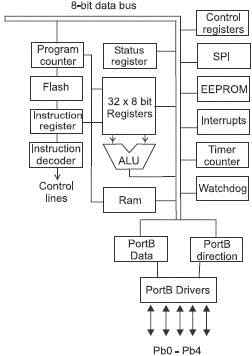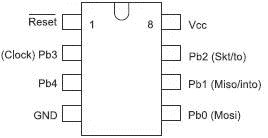Книга: Introduction to Microprocessors and Microcontrollers
AVR 8-bit RISC microcontrollers
AVR 8-bit RISC microcontrollers
Taking the AT90S/LS2343 as an example, we can see a really basic microcontroller with minimal complexity yet having many useful features that make it inexpensive, small and comparatively fast. The RISC design and the width of the registers allows the vast majority of instructions to be executed in a single clock cycle and all the others, apart from five, are completed in two cycles.
In Figure 15.5, we have a block diagram. It is quite a relief to see that mostly it is quite familiar after looking at the earlier 8-bit microprocessors and the 8051 considered in previous chapters. Already we see that most devices are a combination of one or two innovative ideas added to a standard mix.

Figure 15.5 AVRAT90S/LS2343
Inputs and outputs
One notable feature of the block diagram, we see only five input/outputs shown as PortB 0 to 4 so we have only five connections for data which is a small number until we look at the sister version, the AT90S/LS2323 which has only three – PortB 0 to 2! Yet they are called 8-bit devices and in previous 8-bit micros we have grown to expect at least one and sometimes two 8-bit input/output connections. The answer is just that the ‘8-bit’ description refers to the internal data bus width.
The PortB pins can be used to send data in either direction, they can be used as inputs or outputs. As is common with other microprocessors and microcontrollers, the direction of data movement through each of the PortB lines is individually controlled by a data-direction register. Loading a ‘one’ into the data-direction register will make the corresponding PortB line into an output, on the other hand a ‘zero’, of course, will change it into an input.
Memories
This microcontroller has three memories, or four if we count the general purpose registers. The loading of the memory storage areas employs a serial transfer of data and is achieved by the SPI (serial programming interface).
One ROM storage area is achieved by a Flash memory organized as 1k?16. The program instructions are all either 16 or 32 bits wide and can be cleared and reprogrammed whilst remaining in circuit. It can be cleared and reprogrammed at least 1000 times. The contents of the Flash memory cannot be changed by the program being executed by the CPU and so is free from accidental corruption. The data is held in an EEPROM, which again can be cleared and reprogrammed electronically without removal from the device. It only holds 128 bytes of memory but is able to go through at least 100 000 cycles.
Data corruption can occur in the EEPROM if the supply voltage is reduced too far but this effect can be avoided by any one of the following three methods. The first we have already mentioned – use the Flash memory for critical data. The other two methods are ways to detect the reduction in voltage and immediately put the microcontroller into a safe condition. This is often referred to as ‘brown out protection’. An external circuit detects the falling voltage and applies a low voltage to the reset pin which effectively switches the chip off until the supply voltage recovers. The alternative is to put the microcontroller into a power-down sleep mode which is a power saving mode which has the effect of preventing any decoding or execution of any instructions – which, of course, precludes any ‘writes’ to the EEPROM.
It also has 128 bytes of SRAM (Static RAM) for the temporary storage of data and 32 8-bit general purpose registers that can be connected two at a time with the ALU (arithmetic and logic unit) which is the heart of the ‘brain’ within the microcontroller.
Clock
The AT90S/LS2343 has an internal RC oscillator which runs at 1 MHz, 4 MHz or 10 MHz depending on the version in use. It is one of the few of the micro devices that does not make use of an external crystal although it can use an external clock pulse. This external clock pulse only requires a single pin and hence we have an extra pin to use as an output.
Interrupts
There are only three interrupts. The first, and highest priority, is the reset which is activated by a low voltage applied to pin 1, a power-on reset or a signal from the watchdog. The next is an external interrupt request as described in a moment. Lastly, an overflow from the timer/counter circuit.
Pinout and package
These are shown in Figure 15.6 and we can see that it is available as an 8-pin DIL (dual in line) package which has two lines of pins and also the surface mount version, plastic gull wing SOIC (small outline IC).

Figure 15.6 AT90S/LS2343 pinout
Pin 1 – Active low reset. Must go low for at least 50 ns.
Pin 2 – External clock signal input or PortB 3
Pin 3 – PortB 4. All lines can sink 20 mA and therefore are able to power LEDs directly. Sinking means that the LED or other load is connected between the positive Vcc supply and a low voltage output at the port.
Pin 4 – Ground.
Pin 5 – PortB 0 or MOSI. In serial programming mode, MOSI is the serial data input.
Pin 6 – PortB 1 or MISO/INT0. In serial programming mode, MISO is the serial data output. This pin can also act as the external interrupt described in the previous paragraph.
Pin 7 – PortB 2 or SCK/T0. In serial programming mode, SCK is the serial clock input. This pin can also provide the timer/counter0 clock input.
Pin 8 – Vcc. The LS version requires a positive supply voltage that remains in the range 2.7–6.0 V.
Sleep modes
When the microcontroller is not being used, it can switch off some of its circuitry to save power. Sleep modes are employed in all modern microcontrollers and make an enormous difference to the overall life of an intermittently used device. This enables sealed units in toys and greetings cards to remain active for months or years.
Idle-mode
To see the benefits, this microcontroller has a normal operating current drain of 2.4 mA but when switched to the ‘idle’ mode, the current falls to 0.5 mA. It does this by stopping the CPU activity but allows the timer/counter, watchdog and interrupts to remain operational. This is about an 80% power reduction but we can do a lot better than that otherwise my musical socks would have stopped long ago.
Power-down mode
In this mode, only the external interrupt and watchdog (if enabled) continue to work and current falls to less than 1 microamp, which is a really impressive reduction in power. The microcontroller can be aroused from its sleep only by one of the following: an external reset, the watchdog (if enabled) or INTO external interrupt.
- Introduction to Microprocessors and Microcontrollers
- State NEW packets but no SYN bit set
- 64-Bit Fedora
- 1.4.1 RISC and CISC
- 9.1.2 Arbitration Field
- 9.5 Bit Stuffing
- 9.7 Nominal Bit Timing
- TOS Bit Manipulation
- Setting the TOS Bits Using ipfwadm or ipchains
- Setting the TOS Bits Using iptables
- Глава 15 Использование шифрования BitLocker
- Шифрование диска BitLocker




